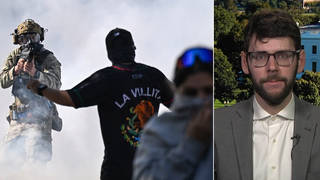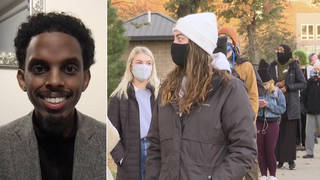
Guests
- Dr. Diane Meierdirector of the Center to Advance Palliative Care and a professor of geriatrics and palliative medicine at the Icahn School of Medicine at Mount Sinai.
We look at solutions and strategies for families when their loved ones are forced to battle COVID alone in hospitals or at home, in Part 2 of our interview with Dr. Diane Meier, director of the Center to Advance Palliative Care and a professor of geriatrics and palliative medicine at the Icahn School of Medicine at Mount Sinai.
Transcript
AMY GOODMAN: This is Democracy Now!, democracynow.org, The Quarantine Report. I’m Amy Goodman, with Nermeen Shaikh, as we go to Part 2 of our conversation with Dr. Diane Meier, looking at the tremendous emotional toll the coronavirus is taking on families when loved ones are forced to battle COVID alone in hospitals or at home. As we continue this conversation on palliative care, we’re still with Dr. Meier, director of the Center to Advance Palliative Care, professor of geriatrics and palliative medicine at the Mount Sinai School of Medicine here in New York City.
Dr. Meier, we talked about these critical problems at this moment. And all over the country, people are dealing with this, their loved ones dying alone. Your power is in coming up with solutions or strategies to deal. And I was wondering if you could do this, everything from not being with your family members to the health professionals and staffs of hospitals, who have to be their replacement when they are so utterly overwhelmed but recognize that they’re the last ones who will see these patients.
DR. DIANE MEIER: These are great questions. And amidst the crisis of this pandemic and its obvious, profound harms globally, nationally, locally, at family levels and individually, I am sure you have seen, as I have, the many stories of transcendence and humanity’s ability to care for one another — I found myself wanting to say “love one another” — despite devastating external contexts and circumstances. And we have seen a lot of this in healthcare.
I think that the people who have both been privileged and burdened to work in hospitals and in healthcare settings during this pandemic have repeatedly commented on the importance of human connection, not only with their colleagues and that strong sort of Band of Brothers feeling among teams of colleagues that are working together — they have each other’s backs. That’s one piece. The other piece is the pride and satisfaction that many health professionals have described to me of being able to connect very sick people with those that they love, using tablets, using telephone, and the profundity of that for all involved, and, in many cases, the remarkable ability of the patients themselves to respond. The people who may not have been responsive, who may have been very sedated, are now — when they hear their loved ones’ voices, come back, come back to life, are able to respond.
So, what does that mean? What does it involve? It’s not a trivial matter to get the family connected to the staff person, and that staff person with the phone or the tablet in the patient’s room. So, first of all, as everyone is aware, the staff are overwhelmingly busy, with one demand after another demand on their time. So, breaking from that running from pillar to post, to actually stop, figure out what the various phone numbers are of the family members, figure out the technology to engage family members who may be from all over the country or in different parts of the world at the same time on a call, and then, having done that, put the phone down, put on your personal protective equipment, which is a 10-minute undertaking, go into the room, prepare the family for what they are going to see, because very often they have no idea what they’re going to see, tell them about the ventilator, tell them what the other machines are, tell them that the patient is sleeping because they are on medicines to help them sleep and not to feel burdened by the ventilator, and then ask the family if they would like to see the patient — and some do, and some don’t — and then talk them through how to speak to their loved one even though their loved one can’t talk back. And that’s very awkward. It’s very awkward to try to talk to someone that isn’t showing you any response. And our human tendency is to assume that they can’t hear us and that there’s no point in trying to communicate. And what we, the health professionals, need to do is remind people that most of the time even people who are sedated or in coma can hear, and particularly they can hear the voices of people that they love, and that there are things to say that are very important to hear for the patient and very important to say for the family.
And there are five things that we often review with the families of people who are very sick or dying, that most families find incredibly relevant and meaningful. And I’ll just run through them with you right now. The five things are, one, “Thank you.” For example, “Thank you for being my mother.” The second is “Please forgive me.” “Please forgive me, Mom, for things that I did when I was 17 that caused you pain.” The third is “I forgive you for things that you may have done that have caused me pain.” The fourth is “I love you.” And the fifth, if the patient is near the end — and some are, some aren’t — is to say goodbye. Saying those five things enables a family member to feel like the important things that may have gone unsaid — and we all know that most of the important things go unsaid in our everyday lives — get said, were said, and were said in time, while our loved one was still there.
So, very often, what we will do is talk through those five things with the family on the phone, ask if they would like to write them down, because most people are in tears by the time we go through that list, and then stay on the phone with them, encourage them, remind them that their loved one can probably hear, that we assume that they can hear, and help them go through those five things, and put the phone or the tablet next to the ear of the patient, turn off the alarms, reduce the ambient noise in the room as much as possible, and help people through saying those things. And it is profoundly meaningful to families to have been able to say the things deepest in their hearts and souls to the people they love, and makes a huge difference in terms of their ability to recover.
Now, as you can imagine, this is not a 30-second conversation, and it may take 10 minutes or 15 minutes, 10 or 15 minutes that hospital staff are having a hard time finding. However, what we’re trying to do is convey the importance and the priority of that level of human connection, for very sick people, to health professionals, nurses, social workers, chaplains, doctors, so that they can facilitate that kind of human connection. And it’s kind of stunning how much gratitude. You would think people would be angry, and
they should be angry. But instead, what we’re getting is gratitude, profound gratitude, from patients, from family members, in the way that we help them be there for each other, thanks to technology that wasn’t there a hundred years ago but is now.
AMY GOODMAN: And how often do you get to facilitate, or do palliative care teams get to facilitate, this in hospitals in New York and all over the country? Of course, this does not include people who are dying at home.
DR. DIANE MEIER: Right. And yes, palliative care teams have been called upon exponentially more often than we were before this pandemic, during the pandemic. And obviously, we are also a scarce resource. There weren’t enough of us, to begin with, before this pandemic started, and there certainly are not enough of us now. But teams have risen to the occasion by figuring out how to scale up our expertise and reach more patients. And one of those ways is through telemedicine and the process of using the phone to talk to and encourage families. And very often it’s the palliative care team that’s talking the family through what to say by phone, while a member of the staff is holding the phone up to the patient’s ears. So, it takes a village to get this done.
In terms of home, we were surprised to find that a fair number of people, when asked by their primary docs, whether that person is an oncologist or an internist or a cardiologist — when asked what they wanted, should they become ill with COVID, should they need to be hospitalized, a surprising percentage of people said, “I don’t want to go to the hospital. I want to ride this out at home, come what may.” And that left us with a conundrum, because it’s fine for people to stay home, but not without care. We had to be able to support those individuals and their families, who were sheltering in place with them or supporting them, to make sure that they got this care and support they needed.
And what many of us did, and in New York, in particular, we set up basically a palliative-care-at-home hotline, in which we were able to be available 24/7 to patients and families who were sheltering at home in place with COVID, to help them figure out what to do if their loved one had a high fever or if they were starting to have difficulty breathing. And we were also able to work with our pharmacy partners to get not only personal protective equipment into the house, so that family members could protect themselves, but also medications. So we were able to deliver, 24 hours a day, seven days a week, to all five boroughs, what we call a comfort pack. And that’s a box of medications that can be used to relieve all different kinds of distress, pain, shortness of breath, anxiety, restlessness, constipation, nausea — anything that would come up. We had a solution in the house, in the refrigerator, in a box, that the family could be talked through using, so that they could, right there, relieve any suffering that emerged, and that we were then there around the clock on the phone to support that process.
And again, necessity was the mother of invention here. We weren’t doing this before the pandemic, although it seems clear that there might be a demand for it through the next phases of the pandemic and thereafter. But the need was so intense. The hospitals were so full and so frightening. People were watching what was going on in hospitals on TV. And a lot of people, you know, said, “I’d rather take my chances at home than take my chances in the hospital.” And we were able to respond to that.
NERMEEN SHAIKH: Dr. Meier, before we end, I just want to ask about the people who are — who have been most vulnerable to COVID-19, namely the elderly. Could you talk about the outbreak at nursing homes, where nearly 30,000 residents and workers have died?
DR. DIANE MEIER: Well, for for many decades, the United States has turned its face away from frail or demented or vulnerable elders. You know, there’s a profound level of fear of aging, and what my former boss, Bob Butler, used to call ageism, that being old is stigmatized. And entering that age group myself, I now know what he was talking about.
And those who are the most vulnerable and functionally impaired, and whose need for care is too high for their families to provide, end up in nursing homes. And so, nursing homes have always been stigmatized. And as an expression of that, we don’t really want to look over there, because we’re terrified we might end up that way ourselves, and we just assume not think about it, thank you very much. We as a society don’t support those places.
So, the financing, which is largely through Medicaid, which is, everyone agrees, totally inadequate to meet the care needs of this group — nursing homes have been grossly understaffed and underresourced for decades, and they still are, coming into this pandemic.
So, now imagine we’re coming into this pandemic. And who are the workers in these nursing homes? They are the essential workers, most of whom are of diverse ethnic groups, most of whom barely are making a living wage, like less than $15 an hour, many of whom are the sole support of large families in crowded apartments or neighborhoods. And while we can stop family members from visiting, we can’t stop the staff from coming in, because if we don’t have staff, we can’t take care of the patients. And so, of course, the staff — underpaid, underresourced, understaffed — are coming in from viral hot spots and bringing the virus in to these very, very vulnerable settings. And the last places to get personal protective equipment, the last places to get any access to testing, of course, have been nursing homes, just as they’re the last places to get money or attention or any other kind of support.
So this was a totally predictable outcome of the way nursing homes and the staff who work in them are undervalued and undersupported in our society. And, of course, the most vulnerable, immunologically vulnerable, population in our society is frail, older persons with preexisting medical conditions like dementia or frailty or heart failure or diabetes. So what we’re seeing in nursing homes was totally predictable.
The only way to address it now would be to get intensive levels of personal protective equipment and literally very high levels of universal testing, with rapid turnaround on testing, both for staff and for residents, to put a stop to this.
AMY GOODMAN: Well, Diane Meier, we want to thank you so much for being with us, director of the Center to Advance Palliative Care, professor of geriatrics and palliative medicine at the Mount Sinai School of Medicine here in New York City.
To see Part 1 of our discussion, go to democracynow.org. I’m Amy Goodman, with Nermeen Shaikh.











Media Options